Giraffes: Like Speckled Towers
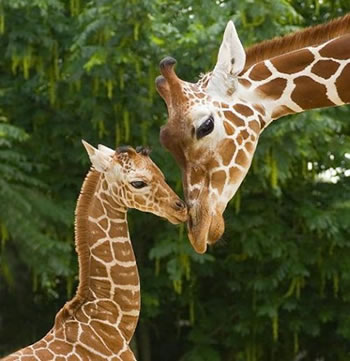
Often reaching a height of five to six metres (15-20 feet), you could find a resemblance between giraffes and speckled towers. The longest part of a giraffe is its neck. Its long neck enables it to reach the remotest branches on trees and feed by grazing on the sprouts and leaves. These thorny plants, which the giraffes don't chew, first go directly into their four-compartment stomach. Then they regurgitate them back to the mouth, where the giraffe chews them. Finally, they swallow them again and send them to another compartment in their stomach.
However, there is something very interesting about this process. As we have recently mentioned, giraffes regurgitate thorny plants from their stomachs back to their mouths to be chewed. But, as you may imagine, this is rather a long journey. The food needs to travel a distance of three or four metres (10-13 feet) in the long neck of the giraffe. As you can also imagine, it is unlikely that the food could proceed to its destination on its own. You are curious about how giraffes could manage this, right? Let us explain it: there is a lift-like system in a giraffe's neck that makes this possible. No doubt, it is impossible for giraffes to think, "In order to digest our food, we need to send it back to our mouths; so, we must build a lift system to accomplish this".
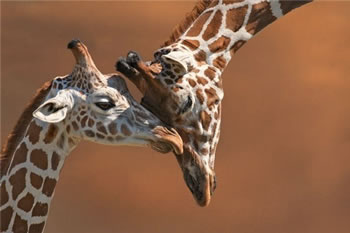
Furthermore, a giraffe is not a lifeless building made up of rocks, soil and mud bricks. It is a living being that runs, feels hungry and delivers babies. Is it possible that such a living being could have come into existence accidentally? Is it possible that coincidence could grant him a long neck equipped with workable systems? Of course not.
It is obvious that anything a giraffe needs has been given it at birth by Allah. Allah has specially created the mouth and stomach structures of giraffes so that they can eat thorny, spiky plants without difficulty.
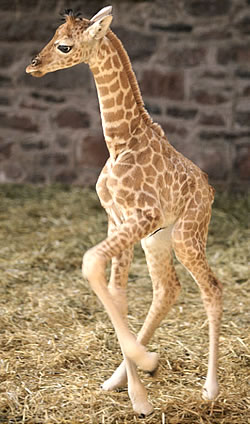
As in the case of the structure of its neck, the way a giraffe sleeps reminds us of Allah's existence. While sleeping, giraffes extend their necks towards their body. Except for a few minutes, they sleep on their feet in this position. Giraffes do not sleep all at the same time; one of them stays awake to protect the others. That a giraffe sacrifices its sleep for the sake of other giraffes and their reaching agreement about this shows us Allah's control over giraffes as in the case of all other animals.
Now, let's set aside how these speckled animals eat their food and talk about the way they drink water. Probably most people have never thought about how a giraffe bends down and drinks water without difficulty. However, our Lord, Who is the Creator of everything, wants us to ponder over such delicate systems.
First, let's make it clear that while drinking water, a serious problem awaits these long-necked creatures.
To understand this essential problem, we need to remember one thing: Do you recall what happens when you try to stand upside down? Exactly! Your face immediately turns red. That is because, our blood rushes to our heads with the effect of the force of gravity and exerts a pressure on the veins, which is called "blood pressure".
This is exactly what should happen when giraffes try to drink water. However, as you may also imagine this could be a major problem. Since giraffes are very tall animals – around five or six metres (15-20 feet) – the blood pressure on the head bending down from such a height becomes very great. If a human being were exposed to such high blood pressure, his brain would immediately burst.
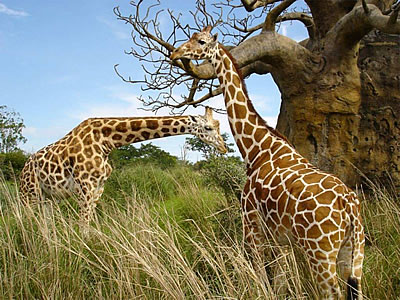
This being the case, how do giraffes drink water without having a cerebral haemorrhage? That is because, Allah, the Creator of space, the sky, the earth and all creatures, has placed a very special mechanism inside a giraffe's head. There are little valves inside the veins of a giraffe's head. Once the height of a giraffe's head changes, these valves start to operate and prevent high blood pressure in the head.
Well, have you ever thought about why giraffes are speckled? This aesthetic appearance, in harmony with the grasslands, makes it hard for their enemies to distinguish the giraffes. Despite their giant bodies, they can thus hide from the king of the savannah, that is the lion, their foremost enemy.
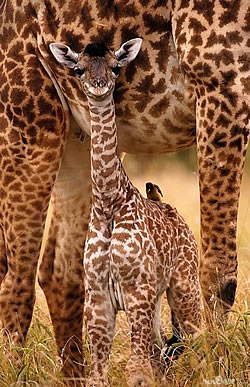
This is, no doubt, not the case for young giraffes. With their premature and weak limbs, they cannot run as fast as their mothers. For this reason, they become easy prey for lions. Yet, as we mentioned earlier, these babies always remain with their mothers. With their long limbs, mothers can give fatal kicks and thus protect them. We must stop here for a moment and think. What we call a 'giraffe' is not a human being. It is an animal. Animals do not have the faculty of thought. So, the protection giraffes and other animals provide for their young becomes possible by Allah's inspiration to them. Allah is the All-Compassionate. Regarding the mercy and compassion of Allah, a verse in the Qur'an reads as follows:
For your Lord is All-Compassionate, Most Merciful. (Surat an-Nahl: 47)
- Introduction
- The Squirrel: The Walnut-Lover
- Rabbits Like Carrots!
- The Loyal Animal: The Dog
- Little White Lambs
- Our Faithful Friends: Horses
- Horses In Stripes: Zebras
- Giraffes: Like Speckled Towers
- Giant Elephants
- Deer: Famous For Their Antlers
- Kangaroos and Their Pockets
- The Koala The Sleepyhead
- Playful Cats Who Want To Be Cherished
- The King of The Jungle: The Lion
- Wild Cats: Tigers
- Masked Pandas
- Bears are Fond of Honey
- Giant Snowmen: Polar Bears
- Fast Swimmers: Seals
- Penguins in Their Tuxedos
- Fisher Puffins
- Sovereigns of The Skies: Birds
- Long-Legged Storks
- A Pink Bird: The Flamingo
- Elegant Swans
- Ostriches (So Big That They can't Fly!)
- The Resplendent Peacock
- A Bird Which Mimics: The Parrot
- Ducks with Green Heads
- The Butterfly: A Miracle of Colours
- Inhabitants of The Oceans: Fish
- The Clown Fish
- Dolphins with Smiling Faces
- Giant Whales
- Conclusion
